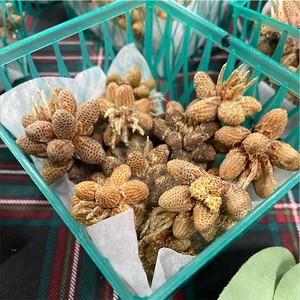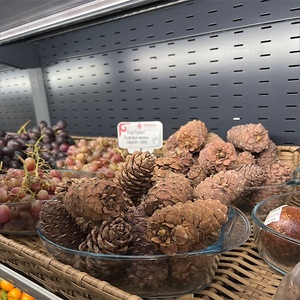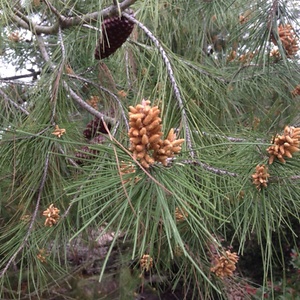


Foraged Pine Pollen Cones
Estimated Inventory, 8 oz : 0
This item was last sold on : 03/27/25
Description/Taste
Pine Pollen Cones are the male reproductive structures of pine trees. Typically very small, they measure about 2 centimeters in length and 1 centimeter in diameter. Their elongated, cylindrical shape resembles a miniature corn cob. These cones exhibit a greenish-yellow hue and are coated with a slightly resinous substance, featuring numerous small, tightly packed brown scales. These scales lend a bumpy texture and a slightly sticky quality to the cones, helping it adhere to pollinators. When sliced in half, the cones display a dense arrangement of scales, each filled with yellow pollen sacs, creating an appearance similar to the pattern of a pressed flower around its central brown spine. When squeezed, the interior of the Pine Pollen Cone may release a substance that appears liquid but is actually moist pollen. The Pine Pollen itself is a fine dust with a texture akin to extra fine flour. The scent of Pine Pollen Cones is mildly resinous and woody, with subtle sweet and nutty nuances, which is mirrored in their taste—delicately sweet, woody, earthy, and nutty.
Seasons/Availability
Pine Pollen Cones are typically available for a few weeks during late winter and early spring.
Current Facts
Pine Pollen Cones are found on pine trees within the Pinus genus of the pine family, Pinaceae. They produce and release pollen that’s rich in nutrients and bioactive compounds and are often described as "natural micro-nutrient banks" due to their potential health benefits. These cones are considered adaptogens, which are natural substances that help stabilize the body's systems, such as the immune and nervous systems, and increase resistance to various physical and environmental stresses. Pine Pollen has been utilized for thousands of years in Chinese medicine as a restorative longevity tonic and a highly concentrated nutritional source. Pine Pollen is used in geological studies to identify plant types from different geological periods, aiding archaeologists in understanding the crops and cultures of ancient human settlements. It has been used in forensic science to link criminals to crime scenes through the pollen evidence found on their clothing.
Nutritional Value
Pine Pollen Cones are recognized for their rich composition of macronutrients and bioactive compounds, which have shown potential health benefits including anti-inflammatory, antimicrobial, antiviral, antitumor, anticancer, and anti-aging effects. They contain Vitamin D, B-vitamins, and Vitamin E, which support immune health and metabolism. Phytosterols in Pine Pollen Cones may help reduce blood cholesterol levels. They contain phytoandrogens, including bio-identical testosterone, which are used to promote endocrine hormonal balance—a quality rarely found in other plants. In Chinese medicine, Masson Pine Pollen is used to moisten the lungs, relieve fatigue, enhance endurance, support the immune system, improve skin, heart, and gastrointestinal health, increase physical and mental agility, and promote prostate health and weight loss.
Applications
Pine Pollen Cones are harvested for the pollen they contain, ideally foraged just before they release their golden dust. To collect the pollen, place the small, yellow cones in a mesh strainer and shake to release the pollen. Pine Pollen can be consumed directly as a food additive or in tablet form. Its mild flavor makes it easy to incorporate into a wide array of recipes without altering their taste. It can be used in hot breakfast cereals, pancakes, smoothies, soups, stews, cookies, brownies, and pasta sauces. Pine Pollen is also a common ingredient in commercial products like beverages, pastries, and dairy products. It pairs well with bananas, apples, berries, spinach, kale, yogurt, and oatmeal and can be infused into herbal teas and coffees or mixed into energy bars with dates, almonds, chia, and flaxseeds. To create a concentrated tincture, soak the Pine Pollen Cones in alcohol for a month, then strain out the concentrated liquid. For preservation, Pine Pollen powder can be toasted on sheet pans at a low temperature in the oven and then stored at room temperature or frozen. A typical serving size of Pine Pollen is between 1/2 a teaspoon and 1 teaspoon.
Ethnic/Cultural Info
Pine Pollen Cones are referenced in ancient Chinese texts as an integral part of traditional medicine. Shen Nong, a legendary figure in Chinese history revered as the Divine Farmer, is credited with significant contributions to agriculture and herbal medicine. He is associated with the "Shen Nong Ben Cao Jing" (The Divine Farmer's Materia Medica), one of the earliest Chinese texts on herbal medicine, compiled around 200-250 AD, which catalogs hundreds of medicinal plants and substances, including Pine Pollen. Pine Pollen is mentioned in other seminal texts such as the "Newly Revised Materia Medica" (Xin Xiu Ben Cao, AD 659), "Compendium of Materia Medica" (Ben Cao Gang Mu, AD 1590), and "New Compilation of Materia Medica" (Mu Cao Cong Xin, AD 1757). These texts are crucial in the study and practice of traditional Chinese medicine, documenting a broad array of substances used for health and healing across centuries.
Geography/History
The Pine trees from which Pine Pollen Cones are derived are native to all continents but are particularly prevalent in Europe, Asia, Mediterranean Africa, North America, and various island nations. These trees thrive in diverse climates, including temperate zones, cold mountainous regions, Mediterranean climates, and subtropical and tropical high elevations. China is the leading producer of Pine Pollen, harvesting over 30 million tons annually. Pine Pollen is produced during the trees' reproductive cycle, with billions of grains released from the catkins, the flowering parts of pine trees, and dispersed by the wind for fertilization. Due to the growing global nutraceutical market, Pine Pollen has gained popularity and is now incorporated into various health products. While Pine Pollen Cones are typically foraged from wild pine trees, Pine Pollen products like powders and tinctures are available at specialty stores and farmers markets that specialize in natural health products.
Recipe Ideas
Recipes that include Foraged Pine Pollen Cones. One
| Cooked |
|
Pine, Pancakes & Pollen |
| The Chalkborad |
|
A Gorgeous Fig + Quinoa Salad With Pine Pollen Dressing |










